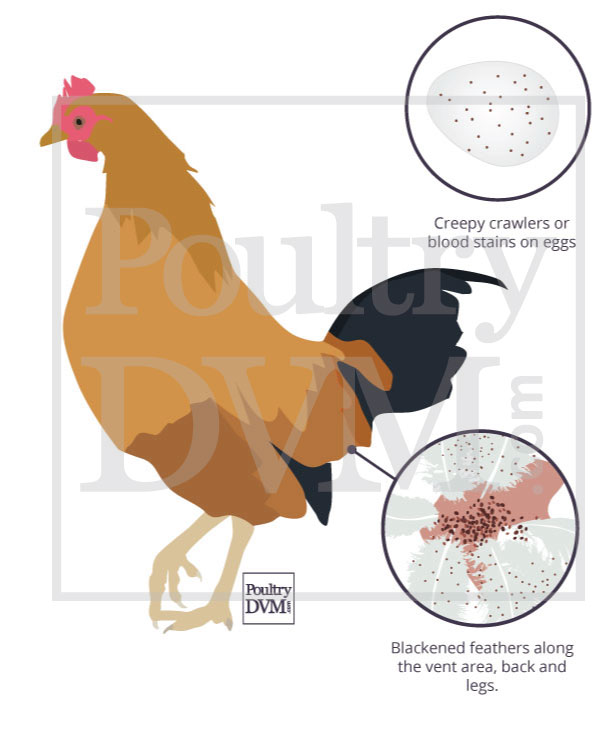Veterinary advice should be sought from your local veterinarian before applying any treatment or vaccine. Not sure who to use? Look up veterinarians who specialize in poultry using our directory listing. Find me a Vet
Other Names: Bird Mites

| Name | Summary | |
|---|---|---|
| Sulfur | Applied as a dust directly on the chickens, added to their dustbathing area or hanging small gauze bags of sulfur dust around the premises. | A Murillo et al., 2016 |
| Fipronil | Spray the base of the neck, tail base, and under each wing and repeat in 30 days | B Speer; Clinical Veterinary Advisor |
| Spinosad (Trade name Elector PSP) | Applied as a spray on all coop housing components. | B Mullens et al., 2017; A Murillo et al., 2017; Dow AgroSciences 2001 |
| Fluralaner (trade name Exzolt) | Added to the flock's drinking water. The product is administered twice, 7 days apart so it treats two mite life cycles. There is no egg withdrawal period and trials show it to be 99% effective at killing mites. | N Hinkle, et al 2018; A Prohaczik et al., 2017; B Mullens et al., 2017 |
| Ivermectin | 0.2 mg/kg PO, SC, IM, topical once and repeated in 10-14 days. | B Speer; W Campbell et al., 1984; S Lee et al., 2006 |
| Garlic spray | 10% garlic solution diluted with water, sprayed on the chicken's vent and abdomen, once every 7 days for 3 weeks. | Birrenkott, G. P., et al., 2000 |
| Diatomaceous Earth (DE) (food grade) | Apply by dusting onto the chicken's feathers or added to their dust bathing area. Also dust all housing components. Replace bedding and nesting material. | A Murillo et al., 2016; C Martin et al., 2012; D Bennett et al., 2011 |
| Malathion | Used as a spray or powder applied to all housing components in coop. | G Damerow |
| Permethrin | Applied as a powder (0.24% permethrin) or spray (3 ounces of 10% permethrin is mixed in a 5 gallon bucket of water), directly on the chickens as well as all housing components. Replace bedding and nesting material. | G Damerow |
| Thyme essential oil | Applied as a spray directly on the mites | T Smith et al., 2017; F Masoumi et al., 2016; D George et al., 2010; IS Nechita et al., 2015; A.M Quilicot et al., 2020 |
| Hemp essential oil | Applied as a spray directly on the mites | MA Tabari et al., 2020 |
| Ajowan essential oil | Applied as a spray directly on the mites | AI Baran et al., 2020 |
| Garlic extract or essential oils | 10% garlic solution diluted with water, sprayed on the chicken's vent and abdomen, once every 7 days for 3 weeks. | Birrenkott, G. P., et al., 2000; A.M Quilicot et al., 2020 |
| Syzygium aromaticum essential oil | Applied as a spray directly on the mites. | MA Tabari et al., 2020 |
© 2025 PoultryDVM All Rights Reserved.